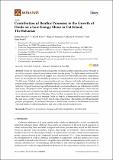| dc.contributor.author | Pruss, Sara B. | |
| dc.contributor.author | Pruss, Sara | |
| dc.contributor.author | Summons, Roger | |
| dc.contributor.author | Newman, Sharon | |
| dc.contributor.author | Mariotti, Giulio | |
| dc.contributor.author | Summons, Roger E | |
| dc.contributor.author | Bosak, Tanja | |
| dc.date.accessioned | 2018-06-25T16:00:04Z | |
| dc.date.available | 2018-06-25T16:00:04Z | |
| dc.date.issued | 2018-06 | |
| dc.date.submitted | 2018-05 | |
| dc.identifier.issn | 2075-163X | |
| dc.identifier.uri | http://hdl.handle.net/1721.1/116564 | |
| dc.description.abstract | Ooids are typically found in frequently reworked coastal sediments, and are thought to accrete by inorganic chemical precipitation around moving grains. The high organic content and the presence of biosignatures, however, suggest that ooids interact with benthic microbial communities. Here, we investigate the role of benthic processes on ooid growth on a leeward shore of Cat Island, The Bahamas. Polished ooids are present in the surf zone, whereas dull ooids and grapestones are present in microbially colonized sediments seaward of the surf zone. Wave hydrodynamics and sediment transport modeling suggest that microbially colonized sediments are mobilized at monthly time scales. We propose a new conceptual model for both ooids and grapestone. Ooids rest and accrete in the area covered by microbial mats, but are periodically transported to the surf zone where wave abrasion polishes them within days. Ooids are then transported back to microbially colonized areas where the accretion cycle resumes. Ooids too large to be transported become trapped outside the surf zone, exit the “conveyor belt” and become grapestones. The benthic growth mechanism predicts petrographic characteristics that match observations: successive ooid laminae do not thin outward, laminae exhibit irregularities, and some ooids include multiple nuclei. Keywords: Pigeon Cay; grapestone; abrasion; carbonate precipitation; microbial mat | en_US |
| dc.description.sponsorship | United States. National Aeronautics and Space Administration (Grant NNA13AA90A) | en_US |
| dc.publisher | Multidisciplinary Digital Publishing Institute | en_US |
| dc.relation.isversionof | http://dx.doi.org/10.3390/min8060252 | en_US |
| dc.rights | Creative Commons Attribution | en_US |
| dc.rights.uri | http://creativecommons.org/licenses/by/4.0/ | en_US |
| dc.source | Multidisciplinary Digital Publishing Institute | en_US |
| dc.title | Contribution of Benthic Processes to the Growth of Ooids on a Low-Energy Shore in Cat Island, The Bahamas | en_US |
| dc.type | Article | en_US |
| dc.identifier.citation | Mariotti, Giulio et al. "Contribution of Benthic Processes to the Growth of Ooids on a Low-Energy Shore in Cat Island, The Bahamas." Minerals 8, 6: 252 © 2018 The Authors | en_US |
| dc.contributor.department | Massachusetts Institute of Technology. Department of Earth, Atmospheric, and Planetary Sciences | en_US |
| dc.contributor.mitauthor | Mariotti, Giulio | |
| dc.contributor.mitauthor | Summons, Roger E | |
| dc.contributor.mitauthor | Newman, Sharon | |
| dc.contributor.mitauthor | Bosak, Tanja | |
| dc.relation.journal | Minerals | en_US |
| dc.eprint.version | Final published version | en_US |
| dc.type.uri | http://purl.org/eprint/type/JournalArticle | en_US |
| eprint.status | http://purl.org/eprint/status/PeerReviewed | en_US |
| dc.date.updated | 2018-06-25T07:43:25Z | |
| dspace.orderedauthors | Mariotti, Giulio; Pruss, Sara; Summons, Roger; Newman, Sharon; Bosak, Tanja | en_US |
| dspace.embargo.terms | N | en_US |
| dc.identifier.orcid | https://orcid.org/0000-0002-0426-5415 | |
| dc.identifier.orcid | https://orcid.org/0000-0002-7144-8537 | |
| dc.identifier.orcid | https://orcid.org/0000-0003-4664-308X | |
| dc.identifier.orcid | https://orcid.org/0000-0001-5179-5323 | |
| mit.license | PUBLISHER_CC | en_US |
